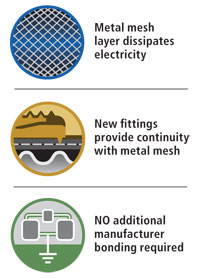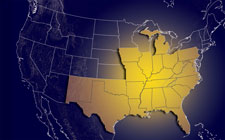

Conductive Layered Jackets
One manufacturer’s protective covering is comprised of two layers of semi-conductive polymer jacketing which sandwich a middle layer of aluminum mesh. The metal mesh material is the same material as used for lightning protection in the aircraft industry. This material was developed and is used to protect composite aircraft parts from the damaging effects of lightning as well. The multi-layered conductive jacket system makes this new CSST system the most resistant to damaging effects from lightning energy and electrical arcing.The jacket system is engineered to thermal and UV resistance requirements. The protective jacket also creates a smooth outside surface over the corrugated tubing that greatly aids in pulling the tubing through tight building spaces and makes it suitable for outdoor use. Such new CSST systems are flexible enough for simple routing through complex building structures and concealed spaces. The jacket on the new CSST system is pre-marked by the foot for easy measuring and installation.

Integral Fitting
A corrosion resistant brass fitting is an integral part of the system as well. The jacket-lock fitting utilizes a multipoint seal for ease in obtaining the gas-tight seal. It also contains a bushing which bites through the jacket’s outer polymer layer and into the metal mesh layer. This penetrating feature of the bushing provides the beneficial electrical continuity from the jacket system and through to the fittings, should the jacket system become energized. The fitting’s jacket-lock feature also protects the stainless steel tubing inside of the fitting from contact with corrosives that could otherwise penetrate the interface. These new fittings have standard NPT threads and may be used in combination with all approved fuel gas piping materials. System components such as manifolds, tees and stub-outs are fabricated from other approved materials to be used with this new flexible CSST system.Certified Lightning Laboratory Tested
This new multi-layered CSST system was tested under controlled conditions in a certified lightning materials test laboratory. The results showed that the multi-layered CSST system outperforms single layered conductive jacketed CSST by more than 10-times. This performance gives contractors and builders who specify the multi-layered system the highest level of lightning protection available in flexible gas piping systems. The CSST system was tested utilizing multiple current waveform testing, representing the return stroke, intermediate currents, and continuing currents. These tests were conducted with peak currents of 41-45 kA and action integrals of 51,000-56,000 A2s.This multi layered CSST system was also tested and listed in accordance with the American National Standard for Fuel Gas Systems Using Corrugated Stainless Steel Tubing, ANSI LC1-2005. This standard lists performance requirements for certification of CSST systems for use with all recognized fuel gases, including Natural Gas and Propane. The ANSI LC1 standard rates CSST for use at pressures up to 5PSI.

Lightning Prone States to Benefit
The multi-layered conductive jacketed CSST system provides all of the installation benefits of standard CSST and eliminates the need for the additional electrical bonding step that manufactures of the standard CSST products require. The product is bonded in the same way as black iron pipe (utilizing the third wire appliance bond) and as mandated by the NEC or local codes. Saving the additional bonding wire step associated with standard CSST is just another advantage of the conductive jacketed CSST products.Areas with high lightning risk include but are not limited to: Alabama, Arkansas, Florida, Georgia, Illinois, Indiana, Iowa, Kentucky, Louisiana, Maryland, Michigan, Mississippi, Missouri, New Mexico, North Carolina, Ohio, Oklahoma, Pennsylvania, South Carolina, Tennessee, Texas, Virginia and West Virginia. One currently available source of information regarding areas more prone to lighting than others is the flash density map provided by the National Weather Service which can be found athttp://www.lightningsafety.noaa.gov/lightning_map.htm.
Safety First
It is important to always follow proper bonding and grounding procedures for CSST systems.These procedures reduce the risk of damage and fire from a lightning strike. Even a nearby lightning strike that does not strike a structure directly can cause metallic systems in the structure to become electrically energized.Bonding and grounding reduces the risk of electrical arcing and potential damage. A qualified contractor always refers to the manufacturer’s design and installation guide for specific details on grounding and bonding the CSST.
Contractors are reminded to also take into account guidance provided by the National Fuel Gas Code, ANSIZ223.1/NFPA-54, National Standard of Canada, Natural Gas and Propane Installation Code, CSA-B149.1, the Uniform Plumbing Code, the International Code Series, the Federal Manufactured Home Construction and Safety Standards, 24 CR Part 3280, the Manufactured Housing Construction and Safety Standards, ICC/ANSI 2.0 or the Standard on Manufactured Housing, NFPA 501 and local codes.
The new CSST system offers the highest level of lightning protection available in flexible gas piping systems and eliminates the need for manufacturer-required bonding. Care should be taken when installing any type of fuel gas piping (including CSST, iron, or copper) by following the manufacturer’s installation instructions. It’s important to consult local building codes as to specific requirements.
Remember, lightning safety depends on you!
Read here for more...